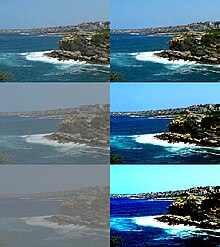Contrast (vision)
This article needs attention from an expert on the subject. Please add a reason or a talk parameter to this template to explain the issue with the article. (November 2008) |


Contrast is the difference in luminance and/or colour that makes an object (or its representation in an image or display) distinguishable. In visual perception of the real world, contrast is determined by the difference in the colour and brightness of the object and other objects within the same field of view. Because the human visual system is more sensitive to contrast than absolute luminance, we can perceive the world similarly regardless of the huge changes in illumination over the day or from place to place. The maximum contrast of an image is the contrast ratio or dynamic range.
Contrast is also the difference between the colour or shading of the printed material on a document and the background on which it is printed, for example in optical character recognition.
Biological contrast sensitivity
The human contrast sensitivity function shows a typical band-pass shape peaking at around 4 cycles per degree with sensitivity dropping off either side of the peak.[1] This tells us that the human visual system is most sensitive in detecting contrast differences occurring at 4 cycles per degree, i.e. at this spatial frequency humans can detect lower contrast differences than at any other spatial frequency.
The high-frequency cut-off represents the optical limitations of the visual system's ability to resolve detail and is typically about 60 cycles per degree. The high-frequency cut-off is related to the packing density of the retinal photoreceptor cells: a finer matrix can resolve finer gratings.
The low frequency drop-off is due to lateral inhibition within the retinal ganglion cells. A typical retinal ganglion cell presents a centre region with either excitation or inhibition and a surround region with the opposite sign. By using coarse gratings, the bright bands fall on the inhibitory as well as the excitatory region of the ganglion cell resulting in lateral inhibition and account for the low-frequency drop-off of the human contrast sensitivity function.
One experimental phenomenon is the inhibition of blue in the periphery if blue light is displayed against white, leading to a yellow surrounding. The yellow is derived from the inhibition of blue on the surroundings by the center. Since white minus blue is red and green, this mixes to become yellow.[2]
For example, in the case of graphical computer displays, contrast depends on the properties of the picture source or file and the properties of the computer display, including its variable settings. For some screens the angle between the screen surface and the observer's line of sight is also important.
Formula


There are many possible definitions of contrast. Some include colour; others do not. Travnikova laments, "Such a multiplicity of notions of contrast is extremely inconvenient. It complicates the solution of many applied problems and makes it difficult to compare the results published by different authors."[3]
Various definitions of contrast are used in different situations. Here, luminance contrast is used as an example, but the formulas can also be applied to other physical quantities. In many cases, the definitions of contrast represent a ratio of the type
The rationale behind this is that a small difference is negligible if the average luminance is high, while the same small difference matters if the average luminance is low (see Weber–Fechner law). Below, some common definitions are given.
Weber contrast
The Weber contrast is defined as
with and representing the luminance of the features and the background luminance, respectively. It is commonly used in cases where small features are present on a large uniform background, i.e. the average luminance is approximately equal to the background luminance.
Michelson contrast
The Michelson contrast[4] (also known as the Visibility) is commonly used for patterns where both bright and dark features are equivalent and take up similar fractions of the area. The Michelson contrast is defined as
with and representing the highest and lowest luminance. The denominator represents twice the average of the luminance. [5]
RMS contrast
Root mean square (RMS) contrast does not depend on the spatial frequency content or the spatial distribution of contrast in the image. RMS contrast is defined as the standard deviation of the pixel intensities:[6]
where intensities are the -th -th element of the two dimensional image of size by . is the average intensity of all pixel values in the image. The image is assumed to have its pixel intensities normalized in the range .
Contrast sensitivity
Contrast sensitivity is a measure of the ability to discern between luminances of different levels in a static image. Contrast sensitivity varies between individuals, reaching a maximum at approximately 20 years of age, and at spatial frequencies of about 2–5 cycles/degree. In addition it can decline with age and also due to other factors such as cataracts and diabetic retinopathy.[7]

Improving contrast sensitivity
It was once thought that contrast sensitivity was relatively fixed and could only get worse with age. However new research has shown that playing videogames can slightly improve contrast sensitivity. [8]
See also
References
- ^ Campbell, F. W.; Robson, J. G. (1968). "Application of Fourier analysis to the visibility of gratings". Journal of Physiology. 197 (3): 551–566. PMC 1351748. PMID 5666169.
{{cite journal}}: Unknown parameter|lastauthoramp=ignored (|name-list-style=suggested) (help) - ^ "eye, human."Encyclopædia Britannica. 2008. Encyclopædia Britannica 2006 Ultimate Reference Suite DVD
- ^ Travnikova, N. P. (1985). Efficiency of Visual Search. p.4. Mashinostroyeniye.
- ^ Michelson, A. (1927). Studies in Optics. U. of Chicago Press.
- ^ http://colorusage.arc.nasa.gov/luminance_cont.php
- ^ E. Peli (Oct. 1990). "Contrast in Complex Images" (PDF). Journal of the Optical Society of America A. 7 (10): 2032–2040. doi:10.1364/JOSAA.7.002032.
{{cite journal}}: Check date values in:|date=(help) - ^ Peter Wenderoth. "The Contrast Sensitivity Function".
- ^ "Contrast sensitivity improvement".















![{\displaystyle [0,1]}](https://wikimedia.org/api/rest_v1/media/math/render/svg/738f7d23bb2d9642bab520020873cccbef49768d)